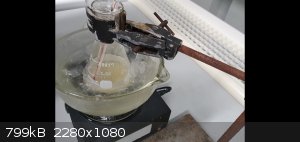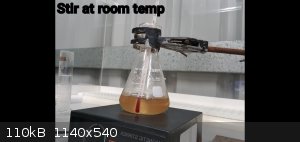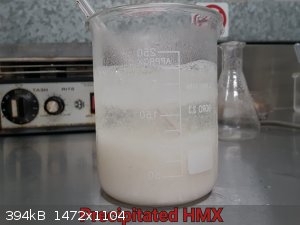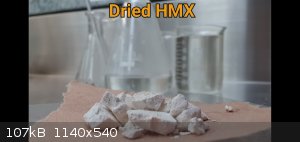| Pages:
1
2
3 |
Nitrosio
Hazard to Self
 
Posts: 57
Registered: 31-3-2018
Member Is Offline
Mood: No Mood
|
|
Attachment: DPT2.pdf (116kB)
This file has been downloaded 767 times
|
|
|
greenlight
National Hazard
   
Posts: 763
Registered: 3-11-2014
Member Is Offline
Mood: Energetic
|
|
HMX second run
Another nitrolysis run was attempted of the DPT.
This time recrystallized pure ammonium nitrate was used and the amount reduced and stirring time was longer.
12 grams of ammonium nitrate was added to 35 ml of white fuming nitric acid with very slight NO2 contamination. The mixture was stirred in an
ice-bath whereupon the ammonium nitrate dissolved giving a clear solution.
Once the temperature reached 5 degrees, slow addition of 4.40g of solid DPT was begun. Each addition caused the mixture to turn cloudy light yellow
before slowly clearing up again. Complete addition took around 20 mins as the temperature was monitored and kept between 6-8°C.
Once complete, the nitrolysis mixture was removed from the ice bath and brought up to room temperature (25-26°C) with a warm water bath. It was held
here with stirring for 40 minutes and an light amber brown solution resulted.
This was then poured into 200ml of crushed ice/distilled water mixture whereupon the desired HMX precipitated out as a fine white powder. It was then
washed with 100ml ice cold water and placed in a desiccator to dry overnight. Will update with yield when dry.
[Edited on 20-1-2021 by greenlight]

 
[Edited on 20-1-2021 by greenlight]
|
|
|
underground
National Hazard
   
Posts: 714
Registered: 10-10-2013
Location: Europe
Member Is Offline
|
|
Nice. How much HMX did you recover ? (yields)
[Edited on 20-1-2021 by underground]
|
|
|
greenlight
National Hazard
   
Posts: 763
Registered: 3-11-2014
Member Is Offline
Mood: Energetic
|
|
Final dried yield is 2.87g which corresponds to a 65% yield which is not too bad. If worked out with the molecular weights in mind, final yield
should be over 6 grams, which means it is within the 45-50% area again.
[Edited on 21-1-2021 by greenlight]

[Edited on 21-1-2021 by greenlight]
|
|
|
underground
National Hazard
   
Posts: 714
Registered: 10-10-2013
Location: Europe
Member Is Offline
|
|
Nice greenlight. You have done a great job so far.
|
|
|
Petn1933
Hazard to Others
  
Posts: 106
Registered: 16-9-2019
Member Is Offline
|
|
Your work was excellent and exemplary. thank you
|
|
|
greenlight
National Hazard
   
Posts: 763
Registered: 3-11-2014
Member Is Offline
Mood: Energetic
|
|
Thanks guys.
I'm quite happy there is a method to obtain HMX without trying to find restricted precursors like acetic anhydride. Still want to do a melting point
and plate test though.
|
|
|
Petn1933
Hazard to Others
  
Posts: 106
Registered: 16-9-2019
Member Is Offline
|
|
Can we use fuming nitric acid instead of white fuming nitric?
|
|
|
greenlight
National Hazard
   
Posts: 763
Registered: 3-11-2014
Member Is Offline
Mood: Energetic
|
|
Using red fuming nitric acid during RDX nitrolysis is a no no because of thermal runaway. Off the top of my head I'm not sure about HMX but to be on
the safe side I would just use white fuming nitric.
By the time I got around to the second nitrolysis run, the clear acid had turned light yellow despite being stored in a fridge but i used it and had
no issues.
[Edited on 28-1-2021 by greenlight]
|
|
|
AndraDoria 13
Harmless

Posts: 2
Registered: 17-4-2019
Member Is Offline
|
|
You did a great job, thank you.
But are we sure the product is pure hmx? I suspected it to be MNX
|
|
|
caterpillar
Hazard to Others
  
Posts: 472
Registered: 8-1-2012
Member Is Offline
Mood: No Mood
|
|
Quote: Originally posted by greenlight  | Using red fuming nitric acid during RDX nitrolysis is a no no because of thermal runaway. Off the top of my head I'm not sure about HMX but to be on
the safe side I would just use white fuming nitric.
By the time I got around to the second nitrolysis run, the clear acid had turned light yellow despite being stored in a fridge but i used it and had
no issues.
[Edited on 28-1-2021 by greenlight] |
I made RDX, using RFNA (it was yellow, as a matter of fact). But I used hexamine dinitrate, not hexamine.
Women are more perilous sometimes, than any hi explosive.
|
|
|
greenlight
National Hazard
   
Posts: 763
Registered: 3-11-2014
Member Is Offline
Mood: Energetic
|
|
Looks like a melting point test is in order then considering I don't have any super advanced equipment like an FTIR or NMR.
|
|
|
greenlight
National Hazard
   
Posts: 763
Registered: 3-11-2014
Member Is Offline
Mood: Energetic
|
|
Quote: Originally posted by caterpillar  | Quote: Originally posted by greenlight  | Using red fuming nitric acid during RDX nitrolysis is a no no because of thermal runaway. Off the top of my head I'm not sure about HMX but to be on
the safe side I would just use white fuming nitric.
By the time I got around to the second nitrolysis run, the clear acid had turned light yellow despite being stored in a fridge but i used it and had
no issues.
[Edited on 28-1-2021 by greenlight] |
I made RDX, using RFNA (it was yellow, as a matter of fact). But I used hexamine dinitrate, not hexamine. |
That is very interesting, I have always heard that white acid must be used, maybe it is a myth after all.
|
|
|
caterpillar
Hazard to Others
  
Posts: 472
Registered: 8-1-2012
Member Is Offline
Mood: No Mood
|
|
Quote: Originally posted by greenlight  | Quote: Originally posted by caterpillar  | Quote: Originally posted by greenlight  | Using red fuming nitric acid during RDX nitrolysis is a no no because of thermal runaway. Off the top of my head I'm not sure about HMX but to be on
the safe side I would just use white fuming nitric.
By the time I got around to the second nitrolysis run, the clear acid had turned light yellow despite being stored in a fridge but i used it and had
no issues.
[Edited on 28-1-2021 by greenlight] |
I made RDX, using RFNA (it was yellow, as a matter of fact). But I used hexamine dinitrate, not hexamine. |
That is very interesting, I have always heard that white acid must be used, maybe it is a myth after all. |
Try this: 5.15.1.3 Nitrolysis of hexamine with ammonium nitrate – nitric acid (CH2)6N4 + 2 NH4NO3 + 4 HNO3 2 RDX + 6 H2O (Eq. 5.24)
This method is known as the K-process after its discoverer K¨offler.201 Like method 5.15.1.2 it uses ammonium nitrate to compensate for the nitrogen
deficiency in hexamine and works to Equation (5.24) where two moles of RDX are produced per mole of hexamine. As observed
with method 5.15.1.2, the addition of ammonium nitrate to nitric acid appears to prevent dangerous oxidation reactions from occurring. In fact, this
nitrolysis reaction only occurs at elevated temperature and so a constant temperature of 80 ◦C is usually maintained throughout the reaction. Yields
of approximately 90 % are attainable based on one mole of hexamine producing two moles of RDX. And hexamine dinitrate is always better than hexamine.
Women are more perilous sometimes, than any hi explosive.
|
|
|
greenlight
National Hazard
   
Posts: 763
Registered: 3-11-2014
Member Is Offline
Mood: Energetic
|
|
Hello fellow EM chemists,
I am revisiting this method of HMX synthesis for two reasons:
1. To see if the entire process is scaleable x 6.
2. To get a purer recrystallised sample of HMX to obtain a better melting point to assess purity. I have purchased a melting point apparatus.
I have a 150g urea nitrate batch just dry and ready to be reacted with sulfuric acid to nitrourea.
|
|
|
DennyDevHE77
Hazard to Others
  
Posts: 168
Registered: 15-9-2014
Member Is Offline
Mood: No Mood
|
|
About a year ago I posted an article where DPT for HMX was synthesized through descaler rather than nitrourea, but for some reason everyone is chasing
nitrourea....
There she is https://www.sciencemadness.org/whisper/viewthread.php?tid=15...
[Edited on 5-8-2024 by DennyDevHE77]
|
|
|
greenlight
National Hazard
   
Posts: 763
Registered: 3-11-2014
Member Is Offline
Mood: Energetic
|
|
That is a very interesting read with some thorough experimentation included.
At the time this thread was made I had no idea there was another method out there. This procedure was very attractive at the time due to acetic
anhydride not being required which is a win considering the high level of restriction applied to it in the majority of countries.
I believe this route is popular due to the fact that high strength nitric acid is only required once for the last step. Nitric acid is difficult to
acquire in quantity for a lot of home chemists.
There are disadvantages in this method though as stated in the link. The large quantity of formaldehyde required versus DPT yield. Secondly, a large
quantity of sulfuric acid is required for the nitrourea synthesis.
I am interested to see how this method goes when scaled up and the purity of the final HMX after recrystallisation though as I never got that melting
point
[Edited on 5-8-2024 by greenlight]
[Edited on 5-8-2024 by greenlight]
|
|
|
ManyInterests
National Hazard
   
Posts: 966
Registered: 19-5-2019
Member Is Offline
|
|
This thread is interesting because I also have an interest in synthesizing RDX and possibly HMX (they are related compounds if I am not mistaken). The
main issue I have with RDX is that for some reason or another, I am having a hard time making WFNA (1.50 SG), Maybe it's because my sulfuric acid was
diluted from storage, I am not sure. I did not redistill my nitric acid with sulfuric acid yet, but that would probably fix my issue.
| Quote: | | That is very interesting, I have always heard that white acid must be used, maybe it is a myth after all. |
| Quote: | | I made RDX, using RFNA (it was yellow, as a matter of fact). But I used hexamine dinitrate, not hexamine. |
Isn't RFNA around 85% to 95% concentration? And since I never used hexamine to make the little RDX that I did make, maybe HDN with that concentration
+ some freshly dried ammonium nitrate added to it (which I have plenty of now) maybe that would work? I was able to make that concentration well
enough.
|
|
|
greenlight
National Hazard
   
Posts: 763
Registered: 3-11-2014
Member Is Offline
Mood: Energetic
|
|
Quote: Originally posted by ManyInterests  | This thread is interesting because I also have an interest in synthesizing RDX and possibly HMX (they are related compounds if I am not mistaken). The
main issue I have with RDX is that for some reason or another, I am having a hard time making WFNA (1.50 SG), Maybe it's because my sulfuric acid was
diluted from storage, I am not sure. I did not redistill my nitric acid with sulfuric acid yet, but that would probably fix my issue.
| Quote: | | That is very interesting, I have always heard that white acid must be used, maybe it is a myth after all. |
| Quote: | | I made RDX, using RFNA (it was yellow, as a matter of fact). But I used hexamine dinitrate, not hexamine. |
Isn't RFNA around 85% to 95% concentration? And since I never used hexamine to make the little RDX that I did make, maybe HDN with that concentration
+ some freshly dried ammonium nitrate added to it (which I have plenty of now) maybe that would work? I was able to make that concentration well
enough.
|
Yes the two are related and similar in structure, they are also often present in small percentage as by-products of each other's synthesis.
Definitely redistill if you think your acid isn't concentrated enough with an excess of fresh sulfuric to eliminate any variables on that side of
things. I believe the distilled nitric is above 90% when done properly and yellow in colour with a lot of fuming when in an open vessel.
Bubble some dry air through it and the resulting acid will be crystal clear.
Have you tested the density of your acid? A few drops of high concentration nitric in contact with nitrile gloves will cause them to self ignite.
The addition of ammonium nitrate during nitrolysis is a very interesting mechanism. It definitely works well for HMX and it is the ammonium cation in
solution which is thought to enhance the yield although the cation makes a difference too with the nitrate salt responsible for the best results.
There is a paper I have read that investigates this mechanism and lead to those conclusions running side by side tests.
|
|
|
ManyInterests
National Hazard
   
Posts: 966
Registered: 19-5-2019
Member Is Offline
|
|
| Quote: |
Definitely redistill if you think your acid isn't concentrated enough with an excess of fresh sulfuric to eliminate any variables on that side of
things. I believe the distilled nitric is above 90% when done properly and yellow in colour with a lot of fuming when in an open vessel.
Bubble some dry air through it and the resulting acid will be crystal clear.
Have you tested the density of your acid? A few drops of high concentration nitric in contact with nitrile gloves will cause them to self ignite.
|
So in the last few times I made nitric acid, when it had a specific gravity indicating above 75% it was red due to NO2 contamination (hence why a
redistillation is required). I made methyl nitrate recently with some HNO3 that I measured at with a specific gravity of 1.493, but it was red in
color (and all NO2 was purged fully when I added the sulfuric acid).
I rarely tried to react my HNO3 with nitrile gloves. For a bit I didn't trust even vinyl gloves, but an incident were one little drop landing on my
hand that left me with a noticeable scar really made me want to wear gloves. I tested that batch (which was around 87% according to the specific
gravity) on a nitrile glove and I put a minute bit (barely a visible drop) and it burned a sizzling hole in nitrile glove (did not ignite that time,
but I think if I used a bit more it would have ignited). A larger drop on PVC kitchen gloves, however, only left a purple stain. So I wear double
layers of PVC gloves ever since when handling nitric acid or a strong nitrating mixture.
For bubbling dry air, I did do that once and I did make my nitric acid crystal clear, but its specific gravity dropped. This is despite using a wash
bottle with calcium chloride and a makeshift attachment to my air pump (I used one of those air mattress pumps, but I put an attachment also filled
with dry calcium chloride on the air intake).
So basically if it burns nitrile gloves when purged of NO2, it is good enough for RDX?
|
|
|
greenlight
National Hazard
   
Posts: 763
Registered: 3-11-2014
Member Is Offline
Mood: Energetic
|
|
I have never measured the specific gravity of the distilled and purged acids. I have just trusted them by the appearance and properties.
That's interesting about the PVC gloves, I have always chosen to not wear gloves when handling high strength nitric due to the fact I would rather
wash it straight off with water if any contacted my skin instead of remove melted burned gloves from my hands.
Was you nitric acid still highly fuming after you had bubbled dry air through it?
I just put my air pump (aquarium pump) into a dessicator bowl and covered it in calcium chloride when performing the NOx removal.
I don't think it's that rudimentary, but if it burns nitrile gloves when distill it's a good sign the concentration is high. Below I have attached
two photos of about 0.3 ml of red fuming distilled nitric acid pipetted onto a nitrile gloves. The first photo is approximately 2 seconds after
contact and the second photo a second later when ignition took place.
[Edited on 8-8-2024 by greenlight]
 
|
|
|
ManyInterests
National Hazard
   
Posts: 966
Registered: 19-5-2019
Member Is Offline
|
|
Nurdrage and Nile Red on youtube have shown that disposable vinyl gloves will stand up to WFNA. I tested kitchen PVC gloves (since they are much
thicker and also grip better) and the acid also did not penetrate the outer layer.
When I got the acid on my hand, I plunged my hand into a bicarbonate bath and got a bottle of bicarbonate solution and it did nothing. I still ended
up with a scar on my hand. 
But getting past that, so you are more concerned with the reactivity of the acid than the weight/volume? I will try that, it could make my life easier
if it'll still make RDX and PETN with the nitric acid acid alone. I haven't bubbled air through acid in a while. I still have some fuming acid, but I
won't be using it for a while. I might test it on that. I got a little bit of yellow stains on my fingers (didn't even notice) when I realize the
fumes had escaped from the bottle and apparently coated the sides and bottom. Good thing I kept it on sheets of aluminum foil otherwise it would have
burned my floor!
|
|
|
DennyDevHE77
Hazard to Others
  
Posts: 168
Registered: 15-9-2014
Member Is Offline
Mood: No Mood
|
|
I don't really understand why everyone is paying attention to this. I've had fuming nitric acid on my skin many times. The result was always in the
form of yellowed skin or small ulcers later, also yellow. But it never caused any painful feelings. The most inconvenient thing was that, for example,
a nail dyed yellow would have to grow back before it returned to its color.
|
|
|
Microtek
National Hazard
   
Posts: 920
Registered: 23-9-2002
Member Is Offline
Mood: No Mood
|
|
Measuring specific gravity of red nitric acid is not a reliable way to assessing the concentration. The dissolved NOx alters the density. So the
reason the density of your acid dropped when you bubbled dried air through it was that you had less concentrated nitric acid with dissolved NOx and
when the NOx was purged, the true density could be measured.
In many reactions you can use less concentrated acid with only a minor drop in yield, but I would recommend getting rid of the NOx contaminant in most
cases.
|
|
|
greenlight
National Hazard
   
Posts: 763
Registered: 3-11-2014
Member Is Offline
Mood: Energetic
|
|
@Denny, I agree, the worst you get is a yellow stain on your skin that peels off a few days later as dead skin. There are much worse solution one
could spill on themselves.
@Microtek, agreed, I always get rid of any NOx in the acid before using it in nitrolysis, I feel like it lessens the chance of temperature spikes and
runaways.
An update:
Just reacted 150g of urea nitrate with 550ml of 98% sulfuric acid over the course of a few hours. Hate this dehydration reaction as its so hard to
keep the temperature around zero even with metric tons of ice.
The filtered nitrourea product is drying now.
|
|
|
| Pages:
1
2
3 |